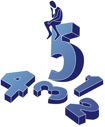How have textbooks in the past presented basic facts?
Traditional textbooks introduce a new operation with a few lessons designed to help students understand what it means to use that operation. For example, for addition the focus is usually on the action of joining sets. For subtraction, the focus is usually on the action of taking away. These lessons are appropriate. However, very seldom are there enough experiences for students to truly understand the meaning of these operations and the various problem structures that occur in the everyday situations. These lessons should be spread over a longer period of time in order to give lower ability students more time to understand.
After the initial lessons, textbooks have practice pages. At this time, the students have no way to solve these problems without counting, usually counting each object that is pictured from one to the total, that is, counting all. These lessons provide students unneeded practice in counting. Textbook lessons never get beyond providing many more of these practice pages. About half of the students do memorize the facts eventually, but the others continue counting to solve basic fact problems for years. These lessons do not promote the more efficient thinking that students need to learn the basic facts, to develop number sense, and to learn mental computation and estimation strategies.
Some of the newer textbooks are designed to be manipulative programs. These textbooks encourage students to use manipulatives to model the problem situations. This helps students learn to directly model the operation. However, since these students are encouraged to represent the problems with counters, they often count from one to the total to answer these problems. When students continue to use counters or their fingers and count all throughout second and third grades, they are not learning the number sense that is needed to be successful in mathematics through the upper grades. Manipulative programs are fine, but teachers have to structure experiences so that students learn new thinking strategies for basic facts and mental computation. Counting all simply does not work with larger numbers.
How do most teachers teach the basic facts?
Teachers usually supplement the textbook with good manipulative activities during the initial textbook lessons. This helps students learn to directly model the operation. Then, typical teachers begin using the practice pages that are provided in the textbook.
After using many of these practice pages, some teachers begin using timed tests. Unfortunately, the students do not have any way to quickly figure out how to solve the harder problems that they have not yet memorized. They are forced to guess, skip problems, or count all. Counting all takes too much time for students to use it and still be successful on timed tests. Many teachers continue to use a combination of practice pages and timed tests for the next several years. Despite the fact that teachers drill students for hours on end through all the elementary school years, nearly half of all adults still count on their fingers to solve addition and subtraction facts above ten.
In contrast, many of the teachers who use manipulative programs do not believe in using timed tests. They believe that timed tests put too much stress on children. They continue to encourage children to use counters to model the problems. This is meaningful to the students, but does not promote new levels of thinking. They often continue to count their fingers into adulthood.
Neither of these approaches is successful with many students. With traditional methods of drill and practice, some students memorize the basic facts rotely, often forget them, and are not able to use their knowledge in new problem situations. With manipulative programs that do not promote the development of thinking strategies, students often use counting far too long.

